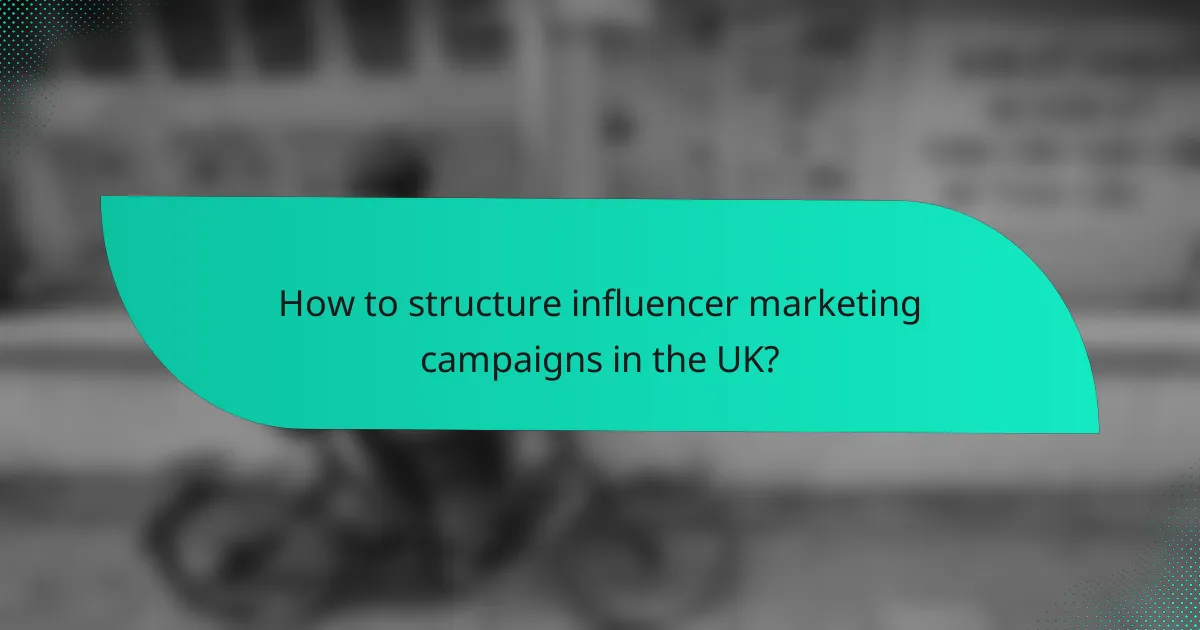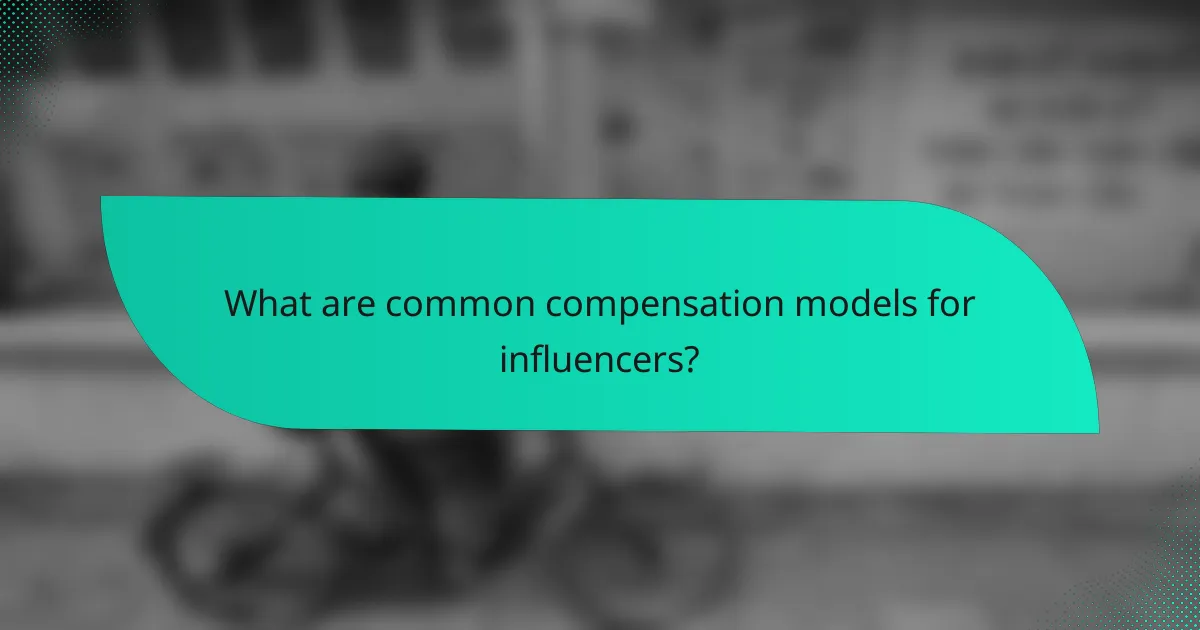Influencer marketing campaigns require a strategic approach that includes setting clear objectives, identifying the target audience, and developing a tailored content strategy. Compensation models such as flat fees, commissions, and product gifting play a vital role in aligning influencer partnerships with campaign goals. Additionally, establishing a well-defined budget based on factors like influencer reach and engagement is essential for maximizing return on investment.

How to structure influencer marketing campaigns in the UK?
Structuring influencer marketing campaigns in the UK involves defining clear objectives, identifying the target audience, developing a content strategy, selecting appropriate platforms, and establishing performance metrics. Each of these elements plays a crucial role in ensuring the campaign’s effectiveness and alignment with brand goals.
Campaign objectives
Defining campaign objectives is essential for guiding the overall strategy. Common objectives include brand awareness, lead generation, and sales conversions. Setting specific, measurable goals helps in evaluating the campaign’s success.
For instance, a brand may aim to increase its social media following by a certain percentage or drive a specific number of website visits through influencer content. Aligning these objectives with broader marketing goals ensures coherence across all channels.
Target audience identification
Identifying the target audience is critical for effective influencer marketing. Brands should analyze demographic data, interests, and online behaviors to create a detailed audience profile. This helps in selecting influencers whose followers match the desired customer base.
Utilizing tools like surveys or social media analytics can provide insights into the audience’s preferences. Understanding the audience’s needs and pain points allows for more tailored and impactful messaging.
Content strategy development
Developing a content strategy involves determining the type of content that resonates with the target audience. This can include videos, blog posts, or social media stories, depending on the platform and audience preferences. Collaborating with influencers to create authentic content is key.
Brands should consider the tone, style, and messaging that align with both the influencer’s voice and the brand’s identity. Providing influencers with creative freedom often results in more genuine and engaging content.
Platform selection
Selecting the right platforms is vital for reaching the target audience effectively. Popular platforms in the UK include Instagram, TikTok, and YouTube, each catering to different demographics and content types. Brands should choose platforms where their audience is most active.
Additionally, understanding the unique features of each platform can enhance campaign effectiveness. For example, Instagram is ideal for visual storytelling, while TikTok excels in short, engaging videos that can go viral.
Performance metrics
Establishing performance metrics is crucial for measuring the success of influencer campaigns. Key metrics include engagement rates, reach, impressions, and conversion rates. Setting benchmarks before the campaign starts allows for effective post-campaign analysis.
Brands should regularly monitor these metrics to assess the campaign’s impact and make necessary adjustments. Utilizing analytics tools can streamline this process, providing real-time insights into performance and audience engagement.

What are common compensation models for influencers?
Common compensation models for influencers include flat fee payments, commission-based compensation, product gifting, and performance bonuses. Each model has its advantages and considerations, depending on the campaign goals and the influencer’s audience engagement.
Flat fee payments
Flat fee payments involve a predetermined amount paid to the influencer for their services, regardless of the campaign’s performance. This model is straightforward and provides budget certainty for brands, making it a popular choice for many campaigns.
When negotiating flat fees, consider the influencer’s reach, engagement rates, and the complexity of the content required. Typical fees can range from a few hundred to several thousand dollars, depending on the influencer’s popularity and niche.
Commission-based compensation
Commission-based compensation ties the influencer’s earnings to the sales they generate through their promotional efforts. This model incentivizes influencers to actively promote the product, as their income directly correlates with their performance.
Brands often use unique discount codes or affiliate links to track sales. Commission rates can vary widely, typically ranging from 5% to 30% of sales, depending on the product and industry standards.
Product gifting
Product gifting involves providing influencers with free products in exchange for promotion. This model is particularly effective for brands looking to build relationships with influencers and generate authentic content without immediate financial outlay.
While product gifting can lead to organic promotion, it’s essential to ensure that influencers disclose the partnership to comply with advertising regulations. This model works best with influencers who genuinely align with the brand and its values.
Performance bonuses
Performance bonuses are additional payments made to influencers based on specific metrics, such as engagement rates or sales targets. This model encourages influencers to exceed expectations and can lead to more impactful campaigns.
When implementing performance bonuses, clearly define the metrics and thresholds for earning bonuses. This could include achieving a certain number of clicks, conversions, or social media interactions, providing a win-win for both the brand and the influencer.

How to determine campaign budgets for influencer marketing?
Determining campaign budgets for influencer marketing involves assessing various factors including the influencer’s reach, engagement rates, and the campaign’s overall objectives. A well-defined budget ensures effective allocation of resources to maximize return on investment (ROI).
Average costs in the UK
In the UK, influencer marketing costs can vary widely based on the influencer’s follower count and niche. Micro-influencers may charge anywhere from £50 to £500 per post, while mid-tier influencers can command £500 to £5,000. Top-tier influencers and celebrities often require budgets in the tens of thousands.
Brands should also consider additional expenses such as content creation, product costs, and potential agency fees when calculating the total campaign budget.
Budget allocation strategies
Effective budget allocation strategies involve prioritizing influencers based on their alignment with brand values and target audience. A common approach is to allocate a larger portion of the budget to high-performing influencers while reserving funds for testing new partnerships.
Consider using a tiered budget model where a percentage is set aside for experimentation with emerging influencers, while the majority supports established partnerships. This strategy helps balance risk and potential rewards.
Factors influencing budget
Several factors influence the budget for influencer marketing campaigns, including the campaign’s goals, target audience, and the influencer’s engagement metrics. Higher engagement rates often justify larger budgets, as they indicate a more responsive audience.
Additionally, the type of content required (e.g., video, stories, or static posts) can impact costs. Campaign duration and the number of platforms used also play a crucial role in determining the overall budget.

What negotiation tactics work best with influencers?
Effective negotiation tactics with influencers focus on building strong relationships, understanding their value, and maintaining flexibility in offers. These strategies help ensure both parties feel valued and can lead to successful collaborations.
Building relationships
Establishing a personal connection with influencers can significantly enhance negotiation outcomes. Take the time to engage with their content, comment on their posts, and understand their brand ethos. This rapport can lead to more favorable terms and a willingness to collaborate on future campaigns.
Consider initiating conversations that go beyond business. Ask about their interests, feedback on previous campaigns, or their thoughts on industry trends. This approach fosters trust and can make influencers more receptive to your proposals.
Understanding influencer value
Recognizing the unique value each influencer brings to a campaign is crucial during negotiations. Factors such as audience demographics, engagement rates, and content quality should inform your compensation offers. Researching these elements can help you propose fair compensation that reflects their influence.
Use tools to analyze an influencer’s reach and impact. For example, platforms like Social Blade or HypeAuditor can provide insights into follower growth and engagement metrics. This data can empower you to negotiate effectively, ensuring both parties feel compensated fairly.
Flexibility in offers
Being flexible in your offers can lead to better negotiation outcomes with influencers. Instead of sticking to a fixed budget, consider various compensation models such as performance-based pay, product exchanges, or tiered payments based on deliverables. This adaptability can make your proposal more appealing.
When discussing compensation, be open to suggestions from the influencer. They may have specific preferences or ideas that could enhance the collaboration. For instance, offering additional perks like exclusive access to events or products can sweeten the deal without significantly increasing costs.

What are the prerequisites for successful influencer partnerships?
Successful influencer partnerships require strategic alignment between the brand and the influencer, along with effective communication throughout the collaboration. Establishing these prerequisites can significantly enhance the impact and authenticity of the campaign.
Brand alignment
Brand alignment involves ensuring that the influencer’s values, audience, and content style resonate with the brand’s identity and target market. This synergy fosters genuine connections with the audience, which can lead to higher engagement and conversion rates.
To assess brand alignment, consider factors such as the influencer’s niche, follower demographics, and previous collaborations. For instance, a fitness brand should partner with influencers who promote healthy lifestyles and have a following interested in fitness-related content.
Clear communication
Clear communication is essential for setting expectations and ensuring that both parties are on the same page regarding campaign goals, deliverables, and timelines. Open dialogue helps prevent misunderstandings and fosters a collaborative atmosphere.
Establish communication protocols early on, such as regular check-ins and updates, to keep the campaign on track. Additionally, providing a detailed brief outlining campaign objectives, key messages, and any legal considerations can streamline the process and enhance overall effectiveness.

How to measure the success of influencer marketing campaigns?
Measuring the success of influencer marketing campaigns involves evaluating key performance indicators (KPIs) such as engagement rates, reach, and conversion rates. These metrics help determine the effectiveness of the campaign in achieving its goals.
Key performance indicators (KPIs)
Key performance indicators (KPIs) are essential for assessing the success of influencer marketing campaigns. Common KPIs include engagement rate, which measures likes, shares, and comments; reach, indicating how many people saw the content; and conversion rate, which tracks actions taken by viewers, such as purchases or sign-ups. Establishing clear KPIs before launching a campaign allows for more accurate measurement of its impact.
Tools for tracking success
Utilizing analytics tools can significantly enhance the measurement of influencer marketing campaigns. Platforms like Google Analytics, Hootsuite, and Sprout Social provide insights into audience behavior and campaign performance. These tools can track referral traffic, engagement metrics, and conversion rates, enabling marketers to adjust strategies in real-time for optimal results.
Evaluating ROI
Evaluating return on investment (ROI) is crucial for understanding the financial impact of influencer marketing campaigns. To calculate ROI, compare the revenue generated from the campaign to the total costs incurred, including influencer fees and production expenses. A positive ROI indicates a successful campaign, while a negative ROI signals the need for strategic adjustments.
